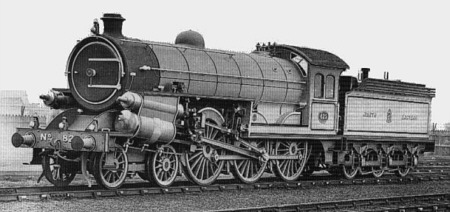The Raven Class B15 (NER Class S2) 4-6-0s

Vincent Raven became the North Eastern Railway's (NER) CME in 1910, and continued the transition to more powerful locomotives to meet the NER's immediate needs. The Class S2 (LNER B15) was Raven's first 4-6-0, and was designed for mixed traffic work unlike the NER's existing 4-6-0s (B13 and B14). The Class S2 incorporated a larger diameter boiler, following the successful use of such boilers on other recent NER designs. The design was finalised June 1911 and an initial batch of ten was built between 1911 and 1912. A second batch of ten was ordered in February 1912, and was built between 1912 and 1913.
The first seven B15s were built with saturated boilers. The remaining thirteen were built with Robinson 24-element superheaters. The saturated B15s eventually had superheaters fitted, and the last B15 was superheated in December 1928. Some of these rebuilds used Schmidt superheaters, but all were eventually converted to use the LNER-standard Robinson superheaters.
In some ways, the B15 was a transitory design. Raven was moving NER large locomotive design towards locomotives with three cylinders and larger diameter boilers. The B15s had the larger diameter boiler, but only two cylinders. Hence they were superceded in 1919 by the three cylinder B16, and the class size remained at twenty locomotives.

The last B15, No. 825, was built with Stumpf Uniflow cylinders. The Uniflow arrangement was intended to avoid condensation in the cylinders, by having separate intake and exhaust ports on the cylinders. Steam flow was in one direction, hence "Uniflow". The main handicap with this system was than the exhaust ports were always of the same size, but the intake ports could vary in size according to the cut-off position. Comparative trials in 1913 were sufficient that after World War 1, the system was fitted to the last of the Class Z (LNER C7) Atlantics. Further experience showed that the improvement was not as great in normal running, and was negated by the special attention required of these two experimental locomotives. In March 1924, No. 825 was rebuilt with conventional cylinders to match the other members of the class.
Although the B15s performed useful work, they shared the B13's property of poor steaming if poorly handled. This made them unpopular with crews that did not have good B15 experience.
The first ten B15s were allocated to Heaton. The second batch was allocated to Dairycoates, Neville Hill and York; with the Uniflow locomotive being allocated to Heaton. Although designed for mixed traffic services, at first they were also used on express passenger trains. The advent of the three cylinder Class Z (LNER C7) Atlantics quickly displaced the B15s to the mixed traffic duties for which they were designed.
By Grouping in 1923, the B15 allocations remained virtually unchanged. The construction of B16s at this time, displaced the B15s from mixed traffic to general goods traffic. A number of the B15s had moved to York and Darlington by 1925. During LNER ownership, the B15s were also used on the Yorkshire coast route, and to haul passenger trains on the GC (Great Central) route from Hull to Sheffield. They also hauled fast goods trains over the Woodhead Route over the Pennines.
Withdrawals started in 1937 with five being withdrawn. World War 2 intervened, and No. 824 was actually withdrawn before being re-instated in 1939. Withdrawals re-commenced in 1944, and the final B15 was withdrawn in December 1947.
Technical Details
| Cylinders: | (2x outside) | 20x26in. |
| Motion: | Gear: | Stephenson |
| Valves: | 8.75in piston | |
| Boiler: | Max. Diameter: | 5ft 6in |
| Pressure: | 175psi | |
| Diagram No.: | 50 | |
| Heating Surface: | Total: | 1730 sq.ft. |
| Firebox: | 140 sq.ft. | |
| Tubes: | 723 sq.ft. (90x 2in dia) | |
| Superheater: | 361 sq.ft. (24x 1.1in dia) | |
| Flues: | 506 sq.ft. (24x 5.25in dia) | |
| Grate Area: | 23 sq.ft. | |
| Wheels: | Leading: | 3ft 7.25in |
| Coupled: | 6ft 1.25in | |
| Tender: | 3ft 9.25in | |
| Tractive Effort: | (@ 85%) | 21,155lb |
| Wheelbase: | Total: | 50ft 8.25in |
| Engine: | 26ft 0.5in | |
| Tender: | 12ft 8in | |
| Weight (full): | Total: | 115 tons 2cwt |
| Engine: | 71 tons 2cwt | |
| Tender: | 44 tons 0cwt | |
| Max. Axle Load: | 19 tons 8cwt |
Preservation
The last B15 was scrapped in 1947, and none of the B15s survived into preservation.
Models
Medley Models sell an O gauge (7mm) kit of the B15.
Acknowledgements
Thank you to Malcolm Peirson for the two B15 photographs.